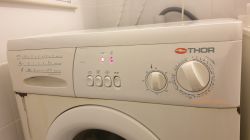Hi everyone,
I hope someone can give me some pointers here. I have an old washing machine, a Thor ST100X, which was working fine until recently. It must be at least 15 years old. When I select any program and put half a load of clothes, it works fine, but when I put a full load of clothes and select any program, the drum does not spin at high speed. Clothes are soaked wet. It looks like it's too heavy tfor the drum to turn at high speed whereas it used to work before. The strangest thing is that the button starts to move by itself (see video). To "solve" this, I have to unload some clothes and rerun the spin feature so clothes get dried.
Thanks for your help on this.
[img-0]

I hope someone can give me some pointers here. I have an old washing machine, a Thor ST100X, which was working fine until recently. It must be at least 15 years old. When I select any program and put half a load of clothes, it works fine, but when I put a full load of clothes and select any program, the drum does not spin at high speed. Clothes are soaked wet. It looks like it's too heavy tfor the drum to turn at high speed whereas it used to work before. The strangest thing is that the button starts to move by itself (see video). To "solve" this, I have to unload some clothes and rerun the spin feature so clothes get dried.
Thanks for your help on this.
[img-0]



